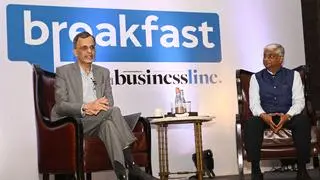Every eighth person living in urban areas is below the poverty line, while one in five rural residents is poor, the Planning Commission has estimated.
According to the new estimates, there has been a sharp reduction in both absolute numbers of poor, as well as the poverty ratio. The poverty ratio has declined to 21.9 per cent in 2011-12 from 37.2 per cent in 2004-05.
The percentage of population below poverty line in 2011-12 has been estimated at 25.7 per cent in rural areas and 13.7 per cent in urban areas. The percentage of population below the poverty line in 2004-05 was 41.8 per cent in rural areas, 25.7 per cent in urban areas, and 37.2 per cent in the country as a whole.
The new estimates, based on 2011-12 Household Consumption Expenditure estimates by the National Sample Survey Organisation, have been arrived at using the methodology suggested by the Suresh Tendulkar committee in 2009.
The Tendulkar panel had redrawn the poverty line at a daily consumption expenditure of Rs 22.42 per person in rural areas and Rs 28.65 in urban areas.
That methodology, as well as the poverty estimates arrived at using it, were widely criticised for under reporting poverty by fixing the consumption levels too low. The Planning Commission subsequently appointed another committee, headed by Chairman of the Prime Minister’s Economic Advisory Council, C. Rangarajan, which is yet to submit its report.
The new estimates, revised based on the consumption expenditure survey, have revised the Tendulkar numbers upwards, but only slightly. The new poverty line pegs daily per capita consumption expenditure at less than Rs 33.33 in cities and Rs 27.20 in villages.
This figure is marginally higher than the cap of Rs 32 for urban area and Rs 26 in rural area for 2010-11 announced last March.
Now, the Commission says, “For 2011-12, for rural areas the national poverty line using the Tendulkar methodology is estimated at Rs. 816 per capita per month and Rs. 1,000 per capita per month in urban areas.”
Thus, for a family of five, the all India poverty line in terms of consumption expenditure would amount to about Rs 4,080 a month in rural areas and Rs 5,000 a month in urban areas. These poverty lines would vary from State to State because of inter-State price differentials, it said.
In actual terms, there were 26.93 crore people below poverty line in 2011-12 as compared with 40.71 crore in 2004-05. The methodology used here factors in money spent on health and education besides calorie intake to fix the poverty line.
The Commission said the decline in poverty is mainly on account of rising real per capita consumption figures.
The Commission has also highlighted the fact that during the 11-year period 1993-94 to 2004-05, the average decline in the poverty ratio was 0.74 percentage points per year. It accelerated to 2.18 percentage points a year during the seven-year period 2004-05 to 2011-12 (during which the UPA has been in power).
Therefore, it can be concluded that the rate of decline in the poverty ratio during the most recent 7-year period 2004-05 to 2011-12 was about three times that experienced in the 11-year period 1993-94 to 2004-05.
The Commission feels that Tendulkar poverty line may be revised by the Rangarajan Committee and that the poverty line may even go up. However, an increase in the poverty line will not alter the fact of a decline, it claimed, while adding that while the absolute levels of poverty could be higher, the rate of decline would be similar.








Comments
Comments have to be in English, and in full sentences. They cannot be abusive or personal. Please abide by our community guidelines for posting your comments.
We have migrated to a new commenting platform. If you are already a registered user of TheHindu Businessline and logged in, you may continue to engage with our articles. If you do not have an account please register and login to post comments. Users can access their older comments by logging into their accounts on Vuukle.